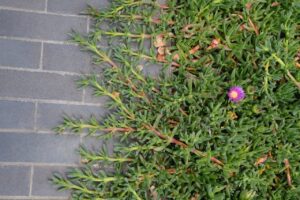Getting into bed with the support act
By Gabrielle Stannus
When we talk about urban landscapes, our attention is often focused on trees and large shrubs. However, much like our natural environments, our designed parks and gardens also would not get by without their ‘understorey’. Taking a stroll around the Inveresk Precinct in Launceston recently, I was reminded of the very important role that plants closer to the ground play in our public landscapes. Garden beds, and the smaller plants contained within them, might only be thought of as the support to the main act, i.e. trees. However, without them the overall result and ambience of these places would not be the same.
The Inveresk Precinct is home to the Queen Victoria Museum, University of Tasmania Stadium (also known as York Park), Launceston Tramway Museum, cafes, and sports grounds. You may be familiar with what locals call the UTAS Stadium, also known as the Tasmanian ‘home’ of Hawthorn, the otherwise Melbourne-based AFL team. On game days, this precinct is packed with people making their way to this venue. More generally, the precinct also attracts visitors to the attractions outlined above, and people walking and cycling through it to the city and seaport. Yes, inland Launceston does have a seaport! This city is located on the kanamaluka / Tamar River estuary which is subject to tidal influences and saltwater influx from the ‘nearby’ Bass Strait (50 to 60 kilometres away). However, I am not here to provide you with a geography lesson. You will have to enrol in one of my units at UTAS for that!
Suffice to say that the Inveresk Precinct is a popular to place to be, and will be even more so once the University of Tasmania’s transition to this location as part of its Northern Transformation is complete. So, a lot of care and consideration has gone into the landscaping of this public space to ensure that interest can be found at all levels of the garden beds and not just in the feature trees. These beds come in different shapes and sizes and feature a selection of native plants to provide colour and movement throughout the year whilst holding up against the elements in this very busy public space. Taking inspiration from this precinct, I would like to provide you with a few tips for making the most out of your garden beds.
First you must find … another shrubbery!
Fans of Monty Python are probably wearing a wry smile reading the heading to this section. This quote comes from the movie “Monty Python and the Holy Grail” and is stated by one of the Knights Who Say Ni, eccentric characters who refuse King Arthur and his knights’ passage through their forest, unless they bring them the gift of a shrubbery. So, you may ask, what is the great appeal behind a shrubbery?
These days, we are more likely to hear a shrubbery referred to as a ‘shrub or mixed border’. According to the University of Melbourne’s Burnley Plant Guide, plants in this category are shrubs that typically have showy flowers but may also be included for their foliage colour and texture, or for their fragrance. They may include smaller shrubs and subshrubs that provide a background, framework, or structure to your planting. To be seen at their best, place plants in your garden bed in descending order of height. If your bed is an ‘island’, i.e. it does not have a wall or fence behind it, place the tallest species in the centre. Once you have this framework, you can then start to fill your garden bed in. Some people choose to include a perennial or herbaceous border, made up of non-woody perennials, to provide floral or foliage interest throughout the year.

Styling up
The good old design principle of grouping odd numbers of plants together absolutely applies in garden beds. Remember though to provide for seasonal floral and/or foliage interest throughout the year. Think too of what may be gained by the ‘loss’ of an element in your bed and how interest might be maintained throughout winter. For example, as leaves fall from deciduous shrubs in autumn, beautifully coloured stems may be exposed, e.g. Cornus sericea (Red Osier Dogwood). Read my article ‘Ooh la la! Winter design tips from France with an Australian twist’ in the August 2023 issue of Hort Journal for more ideas in this space.
Perennial seed mixes can add a wildflower, prairie meadow aesthetic to your garden bed and introduce colour and movement (think Piet Oudolf and the High Line, Manhattan). At the Inveresk Precinct, the garden beds very much have that look and feel about them, albeit using a locally native planting palette. Got a spot in your existing bed to fill? Why not ‘plug’ it literally? Annuals also have their place in garden beds and can provide seasonal interest quickly and relatively inexpensively when planted using plugs. You may even consider edible herbs such as chives and parsley. To add a feature plant as a focal point, consider planting architectural varieties, this time in tubestock to give them that head start in the bed.

Edge effect
We have already spoken about which plants you may like in place in your bed, But what about those plants that you want to keep out, e.g., encroaching turf or other unwanted plants? Those of you who have studied geography or conservation may be aware of what is known as the edge effect. Plants growing along the margins of natural habitats are more exposed to light, wind, cold, heat, and weeds! Which species will thrive in these conditions on your site?
Think carefully about the size and shape of the beds you construct, and how many linear metres you are opening around its edge to potential weed invasion. Not to mention the cost of the materials to edge that bed too. Garden bed edging deserves an article of its own and I may just get around to it some time. However, right now, I will stick to the basics. The longer the border, the more material you will require. That is a bit of a no-brainer really! Some common materials used to edge garden beds include bricks, concrete blocks, logs, sleepers, and stones. What potential is there for you to reuse existing materials to reduce your project’s environmental impact? You could try to get away without edging, however, this may mean unwanted objects end up in your bed, requiring cleaning and/or removal.
Select plants very carefully if your garden bed is in or near an environmentally sensitive area. In my browsing on this topic, I came across the recommendation to include bronze fennel (Foeniculum vulgare ‘Purpureum’) as a backdrop in garden beds. Bronze fennel flowers and sets seeds prolifically, a great quality if you want to infill your bed with minimal maintenance. However, this particular trait makes this fennel highly invasive. Contact your local council for information if you are unsure about the status of the plant in the location you want to plant it in, i.e. is it an environmental weed you should avoid using?

Spillover
Many groundcovers are quick-growing and can suppress weed growth. They also act as a living mulch and retain soil moisture, all particularly useful attributes in public landscapes. The garden beds at Inveresk Precinct use Carpobrotus rossii (Pigface) to good effect here. Remember though that the very qualities that make some plant varieties effective groundcovers, e.g. stoloniferous, rhizomatous, means that they may grow just that little bit too vigorously out of your bed and require ‘tucking in’. Appropriate distance needs to be provided between those groundcovers and foot traffic to ensure those plants are not trampled on, unless of course your garden bed is elevated. In raised beds, groundcovers such as Dichondra ‘Silver Falls’ can be used to spill over edges to dramatic effect and hold soil together above retaining walls.
Access for maintenance
Remember that someone will be required to maintain your design over time, whether that person is a member of your business’ maintenance team, another gardener, or the client themselves. Make it easy for gardeners to access the area within and around the bed. Include paths to the interior of the bed so that gardeners can undertake routine and other maintenance tasks with ease. Paths can be placed discretely to avoid interfering with the bed’s overall appearance. If the garden bed is surrounded by lawn, then make sure that it can be mowed right up to the edge with minimal fuss.

Get in shape!
What sort of shape do you want your garden beds to be in? No, not fitness wise, but that is sort of on the money! Literally, will your garden bed be square, rectangular, circular, or other? And what might that mean for the people who must maintain these beds? Your landscape design might look beautiful on paper or a screen. However, someone needs to help it reach its full potential. Help them to help you do that.
It is not my intention that you should design primarily for maintenance purposes. I do not wish to curtail anyone’s creativity. However, I can tell you from experience that some designers clearly need a tutorial or two on how to incorporate maintenance considerations into their landscape designs. During a brief but rewarding stint in garden maintenance in Melbourne’s eastern suburbs, I saw some design shockers. But that too is a story for another day! Now I am off to ‘bed’ myself.
Gabrielle Stannus
Inwardout Studio
M: 0400 431 277
E: gabrielle@inwardoutstudio.com
(All images: Ludovic Vilbert, Inwardout Studio)

